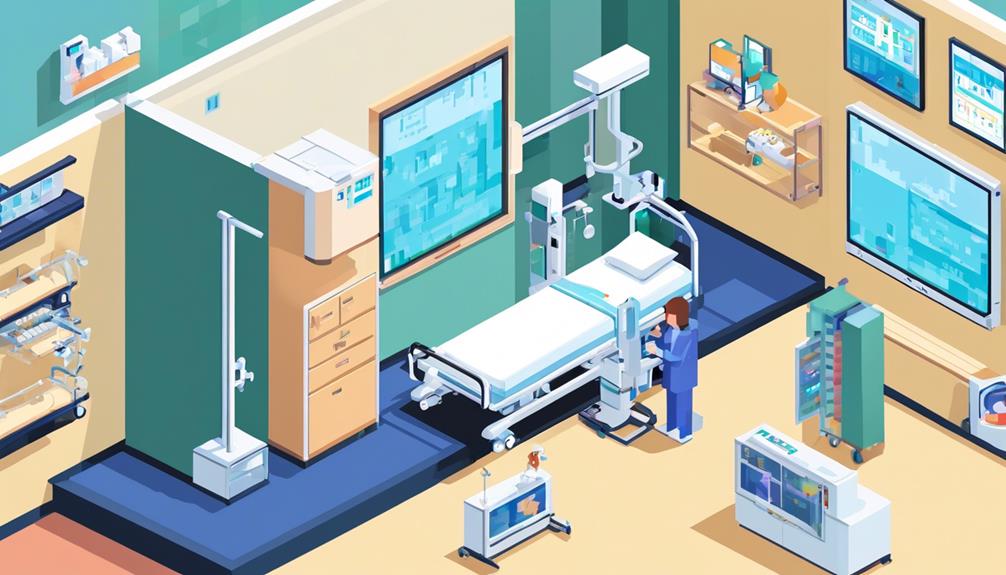Edge computing in healthcare has revolutionized the way medical data is processed and analyzed, offering numerous advantages in terms of real-time patient care and data security. However, the success of edge computing relies heavily on the hardware solutions deployed.
This discussion aims to explore the importance of hardware in edge computing, its role in patient monitoring, the impact it has on data analysis, and the key considerations when choosing hardware solutions for healthcare.
Furthermore, we will delve into the top hardware options available, the benefits of using specialized hardware in healthcare, the challenges faced in implementing edge computing hardware, and the future trends in this rapidly evolving field.
Buckle up as we uncover the essential role that hardware plays in driving the success of edge computing in healthcare.
Key Takeaways
- Edge computing hardware plays a crucial role in healthcare by efficiently processing and analyzing vast volumes of data in real-time.
- Hardware for patient monitoring is essential for seamless transmission of data, timely interventions, and improved patient outcomes.
- Wearables, sensors, and monitoring equipment are key components of hardware for real-time monitoring, enabling continuous tracking of vital signs and immediate data capture and processing.
- Hardware capabilities significantly impact the efficiency and performance of data analysis, and upgrading hardware can enhance data analysis capabilities.
Importance of Edge Computing Hardware
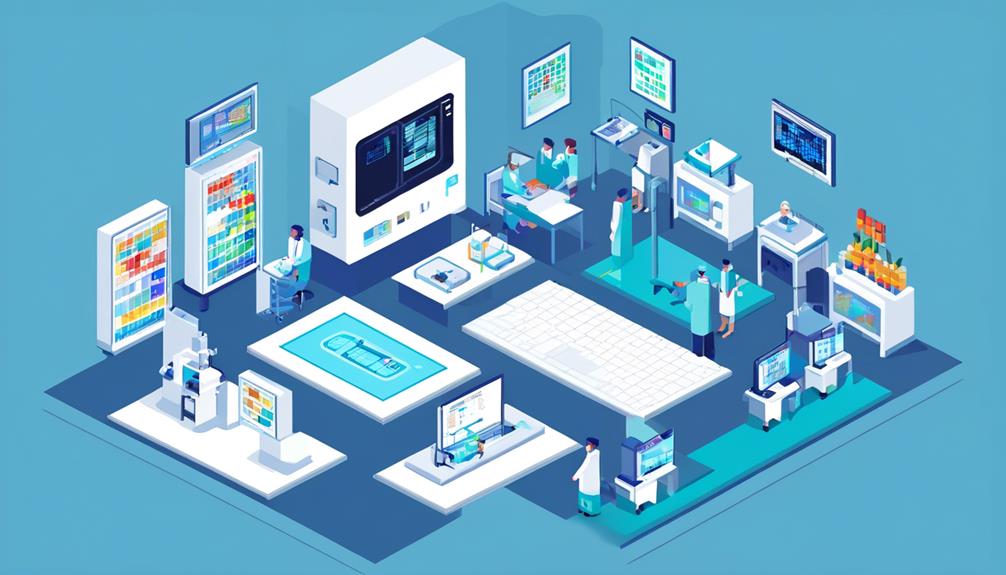
The importance of edge computing hardware lies in its ability to efficiently process and analyze vast volumes of data generated by IoT medical devices in near real-time, facilitating improved patient care, enhanced security, and resource efficiency in the healthcare industry.
Edge computing in healthcare refers to the practice of implementing edge technology to process data at the edge of the network, closer to the source of data generation. Healthcare organizations and providers can benefit greatly from implementing edge computing solutions in their healthcare systems.
One of the key advantages of edge computing hardware is its ability to reduce latency and improve application performance. By processing data using resources on the same LAN, edge computing significantly reduces the time taken to transmit data to a central data center. This not only enhances data security but also enables faster treatment recommendations, improved remote patient care, and enhanced security and HIPAA compliance.
Implementing SD-WAN with edge computing hardware further enhances the efficiency of WAN management and ensures secure transmission of patient data without the need for VPNs. This allows healthcare organizations to streamline their network infrastructure and reduce costs associated with managing virtual private networks.
Additionally, processing most data on-site with edge computing hardware reduces bottlenecking and enhances resource efficiency in healthcare systems. This is particularly beneficial in the management of chronic diseases, where continuous monitoring and real-time analysis of patient data are crucial for effective treatment and timely interventions.
Role of Hardware in Patient Monitoring
The role of hardware in patient monitoring is paramount to the success and accuracy of real-time monitoring. Wearable devices equipped with sensors play a significant role in collecting patient data, allowing healthcare professionals to track vital signs and detect any abnormalities.
These hardware solutions enable the seamless transmission of data for analysis, enabling timely interventions and improving patient outcomes.
Hardware for Real-Time Monitoring
Real-time monitoring hardware, including wearables, sensors, and monitoring equipment, plays a crucial role in facilitating continuous tracking of patient vital signs and health data. These hardware devices enable immediate data capture and processing, ensuring prompt clinical decision support and remote patient care.
In the context of edge computing in healthcare, the role of hardware for real-time monitoring becomes even more significant. Edge computing hardware supports on-site data processing, reducing latency and ensuring real-time insights. By integrating edge devices, healthcare providers can achieve immediate, accurate, and secure data transmission for real-time monitoring. This technology solution is essential for delivering timely interventions and improving patient outcomes.
The hardware for real-time monitoring in healthcare plays a pivotal role in leveraging edge computing to enable seamless remote monitoring, efficient data management, and effective healthcare delivery.
Wearable Devices for Patients
Continuing the exploration of hardware for real-time monitoring in healthcare, a critical component is the utilization of wearable devices for patients. These devices, such as smartwatches, fitness trackers, and medical wearables, are equipped with sensors to track vital signs and activity levels, capturing real-time health data for analysis. The hardware in wearable devices for patients includes sensors for measuring heart rate, blood pressure, temperature, and movement. Moreover, wearable devices often incorporate microcontrollers, low-power wireless connectivity, and batteries for extended usage. These devices not only enable remote monitoring of patients but also play a significant role in managing chronic conditions by providing continuous data for healthcare professionals to make informed decisions. The real-time data captured by wearable devices can be processed using edge computing, allowing for faster and more efficient analysis. This integration of hardware, remote monitoring, and edge computing has the potential to revolutionize healthcare and improve patient outcomes.
| Wearable Devices for Patients | ||
|---|---|---|
| Type of Devices | Sensors | Features |
| Smartwatches | Heart rate, activity | Notifications, fitness tracking |
| Fitness trackers | Heart rate, steps, sleep | GPS, calorie tracking |
| Medical wearables | Heart rate, blood pressure | ECG, fall detection |
Impact of Hardware on Data Analysis
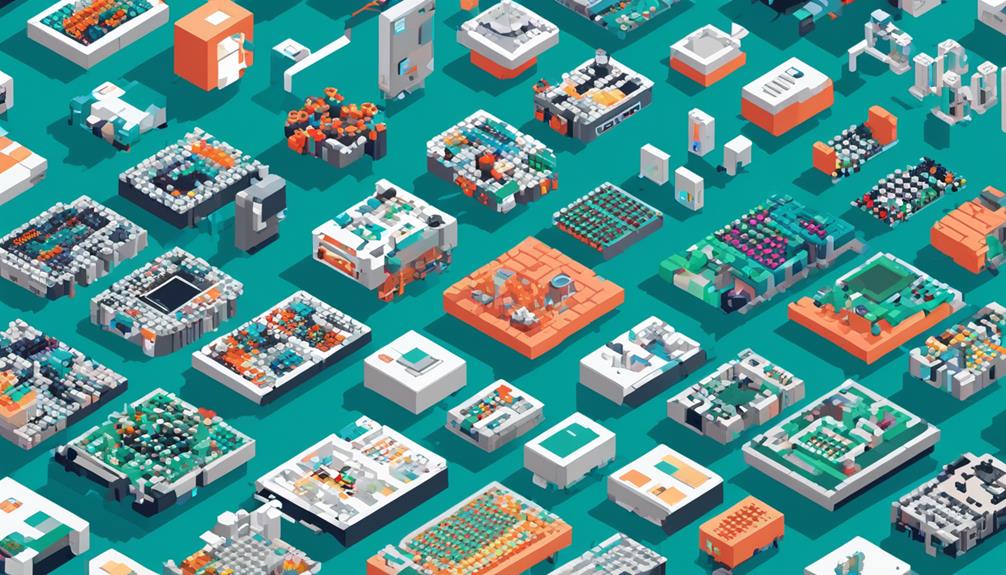
The hardware used for data analysis in healthcare can have a significant impact on the efficiency and performance of the process. Limitations in hardware capabilities can result in slower analysis and suboptimal performance of edge devices.
Therefore, it is crucial to carefully consider the hardware options available to ensure that they meet the requirements for real-time analysis and provide the necessary computational power for accurate and timely insights.
Hardware Limitations in Analysis
Hardware limitations significantly impact the speed and efficiency of data analysis in the healthcare industry. The computing power of hardware directly affects the complexity and size of datasets that can be analyzed, as well as the types of algorithms and models that can be applied to healthcare data.
Processing and memory limitations can pose challenges in handling large volumes of data, hindering real-time analysis capabilities. This can potentially impact the timeliness of patient care decisions, especially in scenarios like remote monitoring where immediate analysis is crucial.
However, upgrading hardware can enhance data analysis capabilities, enabling more comprehensive and rapid insights from healthcare data. By leveraging edge computing and hardware solutions, healthcare providers can better process and analyze data, leading to improved patient care and more informed decision-making processes.
Performance of Edge Devices
Edge devices play a crucial role in healthcare data analysis, as the performance of their hardware directly impacts the speed and efficiency of the process. The processing power and memory of edge devices significantly affect their data processing capabilities.
Specialized hardware accelerators, such as GPUs and FPGAs, can enhance the performance of edge devices in healthcare data analysis by offloading computationally intensive tasks.
Additionally, the storage capacity and data transfer speeds of edge devices are essential for efficiently handling and processing large amounts of healthcare data.
The reliability and durability of hardware components in edge devices are critical for continuous and uninterrupted data analysis in healthcare settings.
Key Considerations for Edge Computing Hardware
When evaluating edge computing hardware for healthcare environments, it is crucial to consider the scalability and flexibility to accommodate increasing data processing requirements. Healthcare facilities generate vast amounts of data, including patient records, medical images, and real-time monitoring data. Edge computing hardware should have the capability to handle the growing volume of data and support future expansion. Scalability ensures that the hardware can handle larger workloads as the healthcare facility grows, while flexibility allows for the integration of new technologies and applications seamlessly.
Another key consideration is the power efficiency and thermal management capabilities of edge computing hardware. Healthcare facilities often require round-the-clock operation, and energy efficiency is essential to reduce operational costs. Furthermore, the hardware should have effective thermal management systems to prevent overheating and ensure reliable and sustainable operation.
Security is of utmost importance in healthcare environments due to the sensitive nature of patient data. Edge computing hardware should incorporate robust security features to protect patient data from unauthorized access or breaches. Compliance certifications, such as HIPAA or GDPR, provide assurance that the hardware meets regulatory standards and safeguards patient privacy.
Compatibility and integration capabilities are also critical factors to consider. Edge computing hardware should be compatible with existing healthcare IT infrastructure and systems to facilitate seamless deployment and operation. Interoperability ensures efficient data exchange and communication between different components of the healthcare ecosystem.
Lastly, the ruggedness and reliability of edge computing hardware should be evaluated. Healthcare facilities can have challenging environmental conditions, such as temperature variations, moisture, and vibrations. The hardware should be capable of withstanding these conditions and ensure continuous operation without compromising performance.
Top Hardware Solutions for Healthcare
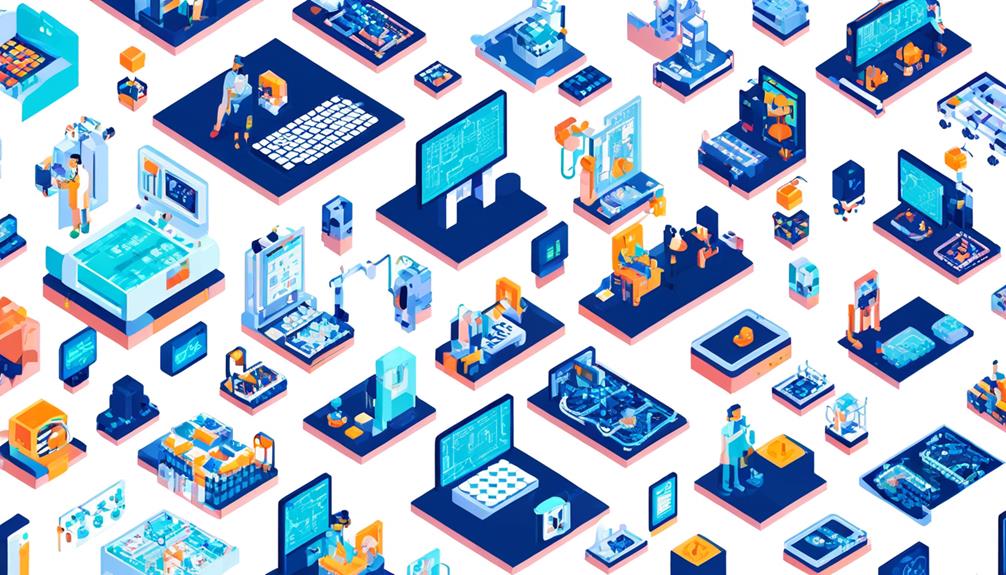
With the rapid growth of the edge computing industry in healthcare, various hardware solutions have emerged to support the increasing demand for efficient data management and improved patient care. These hardware solutions play a crucial role in enabling edge computing capabilities such as low latency, real-time data processing, and analytics. They are designed to meet the specific requirements of healthcare applications, including remote patient monitoring, clinical decision support tools, and machine learning algorithms for data analysis.
Here are some top hardware solutions for healthcare:
| Hardware Solution | Description | Benefits |
|---|---|---|
| Remote Patient Monitoring Solution | Enables healthcare providers to remotely monitor patients' vital signs and health conditions in real-time. | – Allows for early detection of changes in patient's health. <br> – Reduces the need for frequent hospital visits. <br> – Improves patient outcomes and satisfaction. |
| Chronic Obstructive Pulmonary Disease (COPD) Sensors | Monitors the respiratory condition of COPD patients. | – Provides continuous monitoring of lung function. <br> – Alerts healthcare providers in case of emergencies. <br> – Enables personalized treatment plans. |
| Edge Servers with Machine Learning Capabilities | Enables real-time data processing and machine learning algorithms at the edge. | – Reduces the dependency on cloud for data analysis. <br> – Enables faster and more accurate clinical decision support. <br> – Enhances patient privacy and data security. |
These hardware solutions, combined with edge computing, offer significant advantages in healthcare. They enable healthcare providers to deliver timely and personalized care to patients, improve diagnosis accuracy, and enhance treatment outcomes. Furthermore, by processing and analyzing data at the edge, healthcare organizations can reduce the bandwidth requirements and latency associated with sending data to the cloud.
Benefits of Using Specialized Hardware in Healthcare
The utilization of specialized hardware in healthcare offers numerous benefits, enhancing the speed, accuracy, and efficiency of remote patient care while ensuring compliance with data privacy requirements and enabling advanced data analytics.
By leveraging edge computing capabilities, specialized hardware enables near-real-time analysis of wearable sensor data, improving the speed and accuracy of remote patient care. This allows healthcare providers to monitor patients remotely and make timely interventions based on the analyzed data.
Additionally, using specialized hardware for edge computing in healthcare ensures compliance with data locality and privacy requirements. With on-premises data storage and processing, sensitive patient information can be securely managed within the healthcare facility, minimizing the risk of data breaches and ensuring compliance with data privacy regulations.
Moreover, specialized hardware brings data analytics and intelligence closer to patients, providers, and diagnostic equipment, thereby enhancing the overall healthcare system. By utilizing Intel technologies, healthcare organizations can convert vast amounts of data into actionable insights, leading to better patient outcomes and operational value. This advanced data analytics capability enables healthcare providers to identify trends, patterns, and anomalies in patient data, facilitating early diagnosis, personalized treatment plans, and efficient resource allocation.
Furthermore, the scalability and processing power of edge computing hardware are well-suited to handle the significant amount of data generated in healthcare settings. For instance, an average hospital produces around 50 petabytes of data each year. Specialized hardware can efficiently process and analyze this data, enabling healthcare professionals to extract valuable insights and make data-driven decisions.
Challenges and Solutions in Implementing Edge Computing Hardware
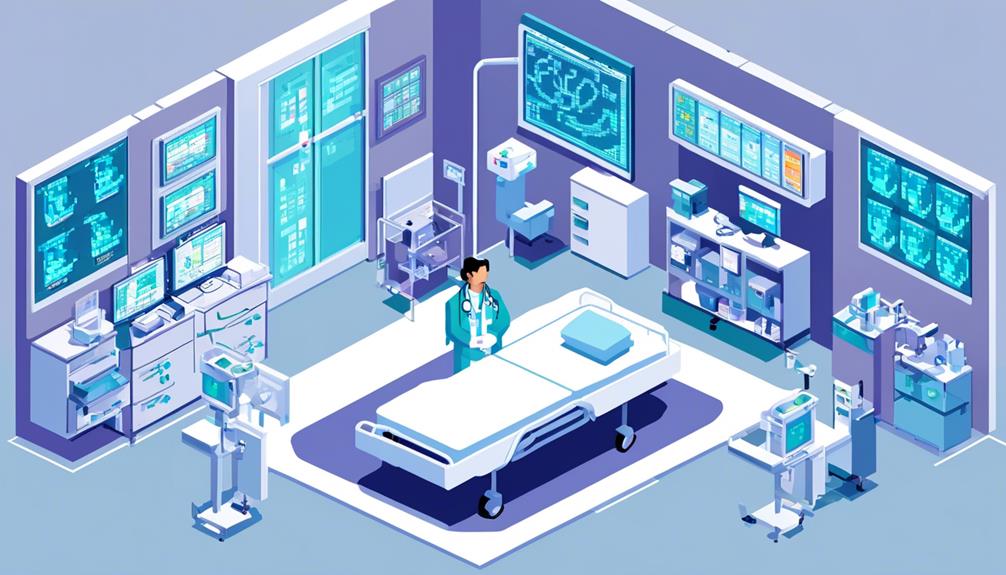
One of the primary challenges in implementing edge computing hardware in healthcare is overcoming bandwidth limitations and network latency when transmitting large amounts of data. The healthcare industry generates vast amounts of data through various sources such as medical devices, electronic health records, and real-time monitoring systems. To enable remote monitoring and improve patient outcomes, this data needs to be processed and analyzed in real-time. However, the traditional cloud computing model may not be sufficient due to the limitations of bandwidth and network latency. Edge computing provides a solution by bringing the computational power closer to the data source, reducing the need for data transmission to the cloud and minimizing latency.
To engage the audience and provide a visual representation of the challenges and solutions in implementing edge computing hardware, the following table highlights key obstacles and their corresponding solutions:
| Challenges | Solutions |
|---|---|
| Bandwidth limitations and network latency | Deploying edge computing infrastructure to process data closer to the source, reducing the need for data transmission |
| Real-time processing and analysis of data | Designing specialized edge computing hardware solutions capable of handling real-time demands |
| Reliable and secure connectivity | Establishing robust connectivity protocols and secure communication channels between edge devices and the central network infrastructure |
| Interoperability and compatibility | Ensuring hardware components from different vendors are interoperable and compatible, allowing seamless integration |
| Security concerns | Implementing stringent security measures to protect sensitive patient data processed and stored at the edge |
Future Trends in Edge Computing Hardware for Healthcare
Future trends in edge computing hardware for healthcare are revolutionizing the way data is processed and analyzed in real-time, leading to improved remote patient care and more efficient treatment recommendations. These trends are driven by the need to leverage the power of edge computing solutions to handle the increasing volume and complexity of health data.
Here are some key future trends in edge computing hardware for healthcare:
- Implementation of intelligent edge devices: Intelligent edge devices are being developed to bring data analytics and intelligence closer to patients, providers, and diagnostic equipment. These devices are equipped with advanced hardware and software capabilities to enable real-time data processing and analysis at the edge.
- Real-time monitoring in ambulances: Edge computing is being deployed in ambulances to enable real-time data processing and analysis, allowing medical professionals to make faster treatment recommendations and preparations. This is particularly crucial for time-sensitive conditions such as stroke or heart attack.
- Improved remote monitoring for chronic diseases: Edge computing solutions are being used to enhance remote monitoring capabilities for chronic diseases such as chronic obstructive pulmonary disease (COPD). By processing and analyzing data from wearable sensors in real-time, healthcare providers can detect early signs of worsening symptoms and intervene promptly.
- Reduction of reliance on the cloud: With edge deployments, healthcare organizations can reduce their reliance on the cloud for data processing and analysis. By bringing computing power closer to the source of data generation, edge computing hardware enables faster response times and reduces the latency associated with cloud-based solutions.
- Advancements in hardware and software technologies: Future trends in edge computing hardware for healthcare will involve continuous advancements in both hardware and software technologies. Companies like Intel are driving these trends by developing technologies that can convert vast amounts of data into actionable insights for better patient outcomes and operational value.
These future trends in edge computing hardware for healthcare are poised to transform the healthcare industry by enabling faster, more accurate data analysis and decision-making at the edge.
Frequently Asked Questions
What Hardware Is Used in Edge Computing?
Edge computing relies on a variety of hardware solutions to enable efficient data processing and storage at the network edge. This includes edge servers, gateways, routers, switches, and IoT devices. These components form the foundation of edge computing architecture, facilitating real-time data collection, local processing, and reduced latency.
Compared to cloud computing, edge computing offers benefits such as improved response times and enhanced privacy and security. However, implementing edge computing in healthcare also presents challenges, including the need for robust edge computing infrastructure and addressing data management and interoperability issues.
Future trends in edge computing hardware include advancements in miniaturization and increased integration with AI and machine learning capabilities.
How Is Edge Computing Used in Healthcare?
Edge computing is revolutionizing healthcare by enabling real-time patient monitoring, remote healthcare delivery, data analytics and predictive modeling, and enhanced cybersecurity. It also improves patient engagement, streamlines medical device connectivity, facilitates telemedicine applications, and enables precision medicine advancements.
By processing data at the edge, healthcare organizations can analyze and respond to patient data in near real-time, improving the quality and timeliness of care. This technology also ensures the security and privacy of sensitive patient information.
Additionally, edge computing enables the use of advanced technologies like machine learning and artificial intelligence for precise diagnoses and personalized treatments.
Which Solution Would Benefit the Most by Using Edge Computing?
Telemedicine applications, wearable devices, remote patient monitoring, medical imaging and diagnostics, real-time analytics, patient data privacy, emergency response systems, and chronic disease management are all healthcare solutions that would greatly benefit from utilizing edge computing.
By leveraging edge computing, these solutions can process and analyze data closer to the source, enabling faster response times, improved accuracy, and enhanced patient outcomes.
Additionally, edge computing ensures data locality and privacy compliance, making it an ideal solution for handling sensitive patient information in a secure manner.
What Are Some of the Common Examples of Edge Computing?
Industrial applications, autonomous vehicles, smart cities, and the retail sector are some common examples of edge computing. Edge computing is increasingly being adopted in various industries to enable real-time data processing and analysis at the edge of the network, closer to the data source. This allows for faster response times, reduced network traffic, improved data privacy, and enhanced operational efficiency.
Edge computing also plays a crucial role in the Internet of Things (IoT), energy management, data analytics, and mobile edge computing. These applications leverage the power of edge computing to handle the massive amounts of data generated by IoT devices, optimize energy usage, analyze data in real-time, and provide low-latency services on mobile devices.
